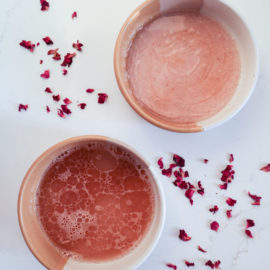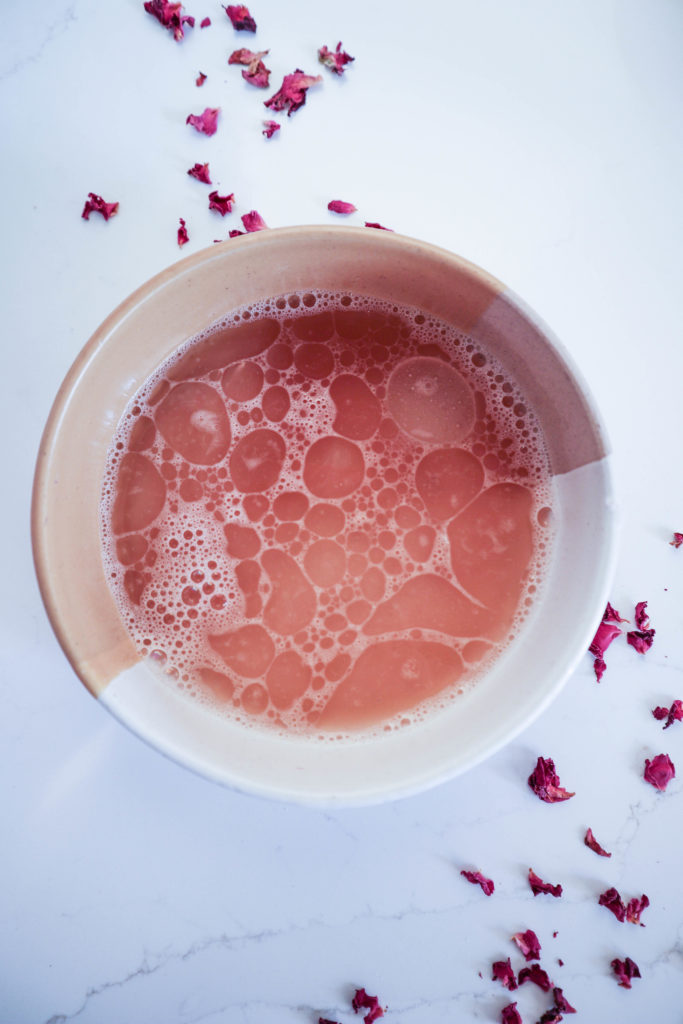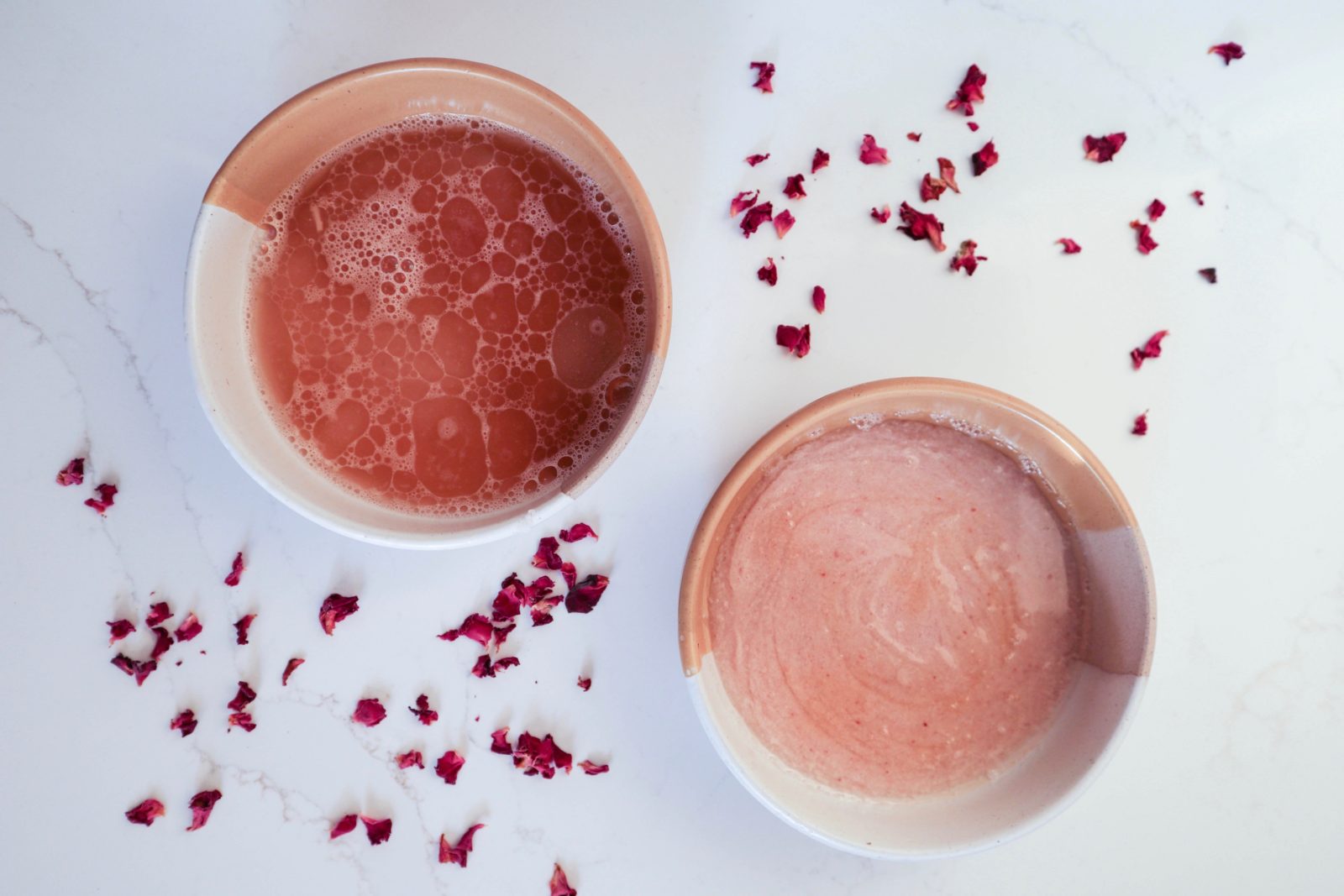Salt scrubs have been popping up recently on shelves in the beauty care products section of stores. There are a few that have some great ingredients, most of them as less than desirable. The true star ingredient is salt, and with such an ingredient you really can just make this at home. It might be a bit of an investment up front, but in the long run, it’s cheaper and cleaner without any of the unnecessary fluff that’s added to commercial products.
Why you Should Try a Salt Scrub?
A salt scrub is a great way to exfoliate and remove personal care product debris that may be lingering on the scalps surface. This might be gels, hair spray, old hair masks, etc. Just as it is great to dry skin brush, it is also great to exfoliate the scalp. Allowing the skin the breath better, increasing circulation, and eliminating build up waste will leave your scalp feeling amazing. The process does not need to be vigorous, take your time and address the entire scalp not just the forelock, or front hairline.

Salt Scalp Scrub
Ingredients
Salt Scalp Scrub with Shampoo
- 1/3 cup himalayan salt or sea salt
- 2-3 tbsp favourite shampoo I used Oneka
- 1 tbsp Oil of choice I use a mix of almond, coconut and a bit of argon
- 10 drops lavender essential oil optional
Salt Apple Cider Vinger Scalp Scrub
- 1/4 cup himalayan salt
- 3 tbsp apple cider vinager
- 1 tbsp Oil of choice I use a mix of almond, coconut, and a bit of argon
Instructions
Salt Scalp Scrub with Shampoo
- Combine all the ingredients together in a plastic bowl or measuring cup. Rinse your hair thoroughly before you begin to apply the salt scrub. Whether you begin with the front or back of your head, go bit by bit and massage the scrub well into your scalp. This might take a few minutes. Shampoo well afterward. I don't use conditioner, instead, I add a bit of oil to my roots.
Salt Apple Cider Vinger Scalp Scrub
- Combine all the ingredients into a plastic bowl or measuring cup. Rinse hair well. Massage the salt and cider scrub into the scalp. Take your time with massaging the scrub in, this might take a few minutes. Shampoo well afterward.
Dandruff – Is your scalp too dry or too oily?
Dandruff is a scalp condition that is characterized by itchy, flaky skin, and the colonization of Malassezia spp. Malassezia spp. is a yeast and common fungi that lives on healthy human skin. However, the yeast does contribute to atopic dermatitis, eczema, folliculitis, seborrheic, and dandruff. The fungi produce IgE antibodies that ignite the release of pro-inflammatory cytokines which leads to inflammation, this occurrence usually happens due to a change in the epidermal layer. For the instance of dandruff, it can be a change in the scalps pH and sebum levels (Glatz, M., et al., 2015) (Saunders, C.W., et al., 2012) (Grimshaw, S.G., et al., 2019), as well as remnants of personal care products on the scalps surface.
Dandruff can be the result of an overly dry or oily scalp. A Korean study that looked at women with healthy scalps and women with dandruff found that the women with dandruff (either dry – low sebum, or oily – high sebum) had scalps with decreased hydration and increased pH. Although both cases found that the scalps both exhibited dehydration and increased pH, addressing dandruff for a dry and oily scalp will require different approaches (Yoon, Ji-Seon, et al., 2020).
Scalp pH – What Happens When it is too Alkaline?
The scalp has a pH of around 5.5, which is similar to the pH of our skin. pH lowering shampoo can be used, however, so can apple cider vinegar or lemon juice, which both have a pH around 2-3. Brining your pH back into balance can also improve frizzing. Frizzing can occur for various reasons, one of which is a highly alkaline scalp. The hair shaft has a pH of around 3.7, when the scalp pH is around 5.5 all should be good. If the pH of your scalp moves from being slightly acidic to being alkaline it results in an increase in a net negative electrical charge for hair leading to frizzing, hair fiber breaking, and hair cuticle damage (Dias, M.F.G., et al., 2014).

Why you Should Massage Your Scalp?
A scalp massage feels amazing, that is reason number one. Your scalp does have muscles, they can get tense and it feels so wonderful to relax and stretch them out. A scalp massage can also help increase circulation and has been shown to increase hair thickness. A study out of Japan that looked at nine healthy men who received a 4-minute scalp massage every day for 24 weeks found that at the end of the test period their hair thickness increased. The scalp massage had changed dermal papilla cell gene expression, approximately 2660 genes were upregulated and 2820 were down-regulated. There was an increase in hair cycle-related genes and a decrease in hair loss related genes (Koyama, T., et al., 2016).
A separate study out of Korea, looking this time at 34 female office workers and the effect a scalp massage would have on their stress, hormone, and blood pressure. They received two scalp massages a week for 10 weeks. The results found significant positive changes in their norepinephrine, cortisol, and blood pressure (Kim, I-H., et al., 2016). Stress has a big impact on hair health. It can lead to excess loss as well as poor hair health.
Why Himalayan salt?
In all honesty, you can just use regular salt, sometimes I go for sea salt instead of the pink stuff. Himalayan salt has a wonderful array of over 84 trace minerals. It is possible, that by massaging the salt scrub into your scalp with the addition of the oils some of those minerals may venture in.
Adjustments to the Recipe
The quantities for the shampoo are ideal for my hair, I have quite long, straight, and thick hair. Everyone’s hair is different. You may need to use less, you may need to use more. Work off it and see how it goes. I use this once a week, and I usually only wash my hair once a week. I do skip a salt scrub for a few weeks and get back on it. I do find with a salt scrub, especially with the added oils that my hair doesn’t get as greasy, it doesn’t tangle as much. I do brush it every evening, and use a silk pillow which I find helps a great deal as well.
One thing I have noticed it has helped with especially is I have a lot less dandruff, and my scalp is not as itchy. I have relatively dry skin, that means my scalp too. The exfoliating from the salt helps with getting rid of dead skin cells, the oils help keep my scalp moisturized, which is especially needed during the dry winter months in Canada.
I have two recipes listed above, one uses shampoo the other uses apple cider vinegar. I find with both it is good to wet the hair first, have your scrub in a plastic cup or bowl (you do not want it to break) and little by little add it to your hair. Scrub gently, massage with a bit of muscle. Massaging your scalp is important to improve circulation (which will bring nutrients to your roots), ease muscles – it will feel absolutely amazing – and relieve tension.

What Oils Should you use?
This will definitely be the most expensive upfront cost. I love using almond, jojoba, and argan oil, however, coconut and olive oil work just fine and are most likely already in your kitchen cupboard.
Castor Oil
Castor oil is another great oil to use, though I must say it is much oilier. If you have drier skin it is one you might like to consider. Caster oil going deeper into the dermis than any other oil, making it a fantastic moisturizer. It is also great for improving hair growth if that is something you are interested in.
Sea Buckthorn
Sea buckthorn oil is high in unsaturated fatty acids, phytosterols, vitamin A and vitamin E, making it a powerful antioxidant and antiinflammatory substance. Though it can be taken internally, topically it is used in the treatment of dermatitis, and other inflammatory skin conditions. Adding in a 1 tsp if you find you have a rather dry scalp, psoriasis or dermatitis can, with time make a difference (Olas, B., 2018).
Argan Oil
Argan oil has traditionally been used in Morocco as a topical oil to treat dry skin, psoriasis, eczema, dermatitis, inflammation, hair loss, and dry hair. Virgin argan oil is made of 99% acylglycerides (oleic and linoleic acid), the rest is comprised of carotenes, tocopherols, sterols, and alcohols. Argan oil has an anti-sebum activity that helps with reducing oiliness (Guillaume, D., et al., 2011). Argon oil is also great for skin barrier repair and wound healing, making it great for psoriasis, eczema, and dermatitis (especially if you scratch a lot).
Extra Virgin Olive Oil
As with all the oils on this list, make sure you use the real stuff. Although olive oil may be easier to find in your kitchen, that does not mean its real extra virgin olive oil. Olive oil contains oleocanthal, an anti-inflammatory compound, the same compound used in Advil, and it is this compound that leaves a burning sensation at the back of your throat if you’ve just tasted the real stuff. Olive oil is a great antioxidant, it works wonderfully for reducing inflammation, which makes it beneficial for those with eczema, psoriasis, and dermatitis. It also aids in wound healing.
Coconut Oil
This antibacterial, antimicrobial, moisturizing oil is the easiest thing to get your hands on, and across the board is great for your hair! It will help with moisturizing a dry scalp, if there is an issue of bacteria, fungi, etc, it will naturally assist with that. Coconut oil aids in repairing the skin barrier, it is anti-inflammatory and wonderful for wound healing.
Jojoba Oil
Jojoba oil, on the pricier end, has been shown to a great natural moisturizer and softener of a dry scalp as its fatty acid profile is very similar to that of oils produced by sebaceous glands of the scalp. Jojoba aids in moisturizing dry hair, reducing the occurrence of split ends and tangles (Sandha, G.K., et al., 2009).
References
Dias, M.F.R.G., de Almeida, A.M., […] Pickler, J. (2014). The Shampoo pH can Affect the Hair: Myth or Reality? International Journal of Trichology. Volume 6, Issue 3, pages 95-99.
Glatz, M., Bosshard, P.P., Hoetzenecker, W., Schmid-Grendelmeier, P. (2015). The Role of Malassezia spp. in Atopic Dermatitis. Journal of Clinical Medicine. Volume 4, Issue 6 pages 1217-1228.
Grimshaw, S.G., Smith, A.M., Arnold, D.S., Xu, E., Hoptroff, M., Murphy, B. (2019). The diversity and abundance of fungi and bacteria on the healthy and dandruff affected human scalp. PLoS One. Volume 14, Issue 2.
Guillaume, D., Charrouf, Z. (2011). Argan Oil. Alternative Medicine Review. Volume 16, Issue 3, pages 275-279.
Kim, I-H., Kim, T-Y., Ko, Y-W. (2016). The Effect of a Scalp Massage on Stress Hormone, Blood Pressure, and Heart Health in Healthy Females. Journal of Physical Therapy Science. Volume 28, Issue 10, Pages 2703-2707.
Koyama, T., Kobayashi, K., […] Ogawa, R. (2016). Standardized scalp Massage Results in Increased Hair Thickness by Inducing Stretching Forces to Dermal Papilla Cells in the Subcutaneous Tissue. Eplasty. Volume 16, e8.
Olas, B. (2018). The beneficial health aspects of sea buckthorn (Elaeagnus rhamnoides (L.) A.Nelson) oil. Journal of Ethnopharmacology. Volume 213, pages 183-190.
Sandha, G.K., Swami, V.K. (2009). Jojoba oil as an Organic, Shelf Stable Standard Oil-Phase Base for Cosmetic Industry. Rasayan Journal of Chemistry. Volume 2, Issue 2, pages 300-306.
Saunders, C.W., Scheynius, A., Heitman, J. (2012). Malassezia Fungi are Specialized to Live on Skin and Associated with Dandruff, Eczema, and Other Skin Diseases. PLoS Pathogens. Volume 8, Issue 6.
Yoon, J-S., Shim, J., Lim, J-M., Park, S.G. (2020). Biophysical characteristics of dandruff-affected scalp categorized on the basis of sebum levels. Journal of Cosmetic Dermatology.
Amanda Filipowicz is a certified nutritional practitioner (CNP) with a bachelor in environmental studies (BES) from York University. She also has certification in clinical detoxification, prenatal and postnatal care as well as nutrition for mental health. She has been working as a nutritionist since 2013 and is a lifelong proponent of eating healthy.

